LAB REPORT
Science and Technology Making Headlines
May 22, 2020

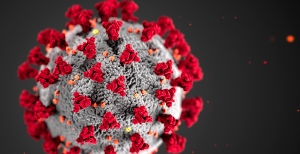
Spike proteins in red, jutting from the SARS-CoV-2 virus, are the leading edge of its attack. Image courtesy of Centers for Disease Control and Prevention
Taking a bite out of COVID-19
Teams of scientists across the United States are using the world's fastest supercomputers, with software that can retarget on the fly, to find the molecular breakthrough that could become the drug with the best chance of disarming the novel coronavirus.
The virus’ skeleton keys are the spike proteins jutting from its surface. The locks are unique receptor cells on the surface of human cells. Find the key, and it becomes possible to stimulate a COVID-19 victim's immune system to manufacture antibodies — defender proteins — with look-alike cellular "locks" that the coronavirus will bind to instead of human cells, neutering the attacker.
“The great part of that approach is, if we can design the antibody to bind to this key location of the [virus] spike protein, we can be fairly confident it will be effective," said Daniel Faissol, a data scientist in the Lawrence Livermore National Laboratory's Computational Engineering Division, which jumped into the coronavirus fight before the consortium was formed.
Before high-performance computing analysis, "we would do an experiment to make that antibody and see if it bonds to the virus and neutralizes it. Those tests take a long time and are very expensive," Faissol said.
Now the lab uses machine learning to guide the search, he said. The technology proposes new designs for possible defender proteins that are then evaluated using computational tools that estimate how effectively the mutation would bind to the coronavirus.
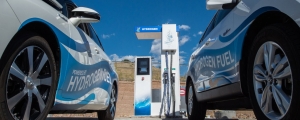
A production facility slated for construction in Lancaster, Calif., will produce renewable hydrogen for fuel-cell stations like this one.
Clean energy of the future
As solar and wind power become cheaper, experts are growing more optimistic about the potential to produce hydrogen through electrolysis powered by renewable energy. In theory, that could make hydrogen an abundant, climate-friendly fuel.
In addition to cleaning up industry and transportation, “green hydrogen” could replace some of the fossil natural gas that homes and businesses use for heating and cooking,
Scientists at Lawrence Livermore National Laboratory studied gasification as part of a recent report. They found that producing hydrogen through gasification of organic waste — basically applying heat and pressure until the waste becomes a gas — could be one of the cheaper strategies for bringing down carbon dioxide concentrations in the atmosphere.
The trick is to understand that organic waste — such as paper goods — might otherwise decompose in landfills, where it would ooze methane, a heat-trapping gas. Diverting that waste from the landfill, and converting it to hydrogen, would avoid some of those emissions. And the hydrogen also would displace a dirtier fuel, such as diesel in a heavy-duty truck.
“There’s a price of hydrogen at which it starts to become economical,” said Sarah Baker, a chemist at Lawrence Livermore and the report’s lead author.

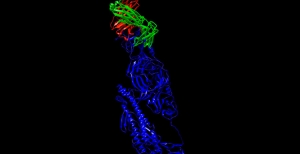
LLNL researchers created a computer visualization depicting the 3D structure of an antibody candidate binding to the protein of SARS-CoV-2.
Rapid response to COVID-19
On the last day of January, the White House declared the novel coronavirus a public health emergency.
At that time, scientists from Lawrence Livermore National Laboratory, jumped in on their own and had already developed initial predictions of the structure of the deadly, mysterious SARS-CoV-2 virus, taking clues from the 2009-10 swine flu pandemic.
"We were in a unique position," said Daniel Faissol, a data scientist at the Livermore Lab and one of the project's leaders. The Livermore team was able to tap a special funding account under the control of the Lab director — a kitty for just such sudden needs and priorities.
"We had Lawrence Livermore internal funding. That allowed us, when the coronavirus started to emerge, to move very quickly," Faissol said.
DOE's $16 billion network of 17 national laboratories is now in a spotlight, with legions of lives — as well as national prestige, to some — at stake in the race to develop vaccines and therapies against the COVID-19 pandemic.

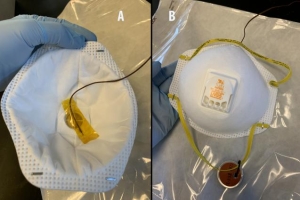
Inner and outer view of an N95 mask between dry heat treatment cycles showing no deformation of the respirator. A thermocouple is affixed to the inner surface of the respirator with Kapton tape to measure the surface temperature of the mask over 10 heating cycles in a standard laboratory convection box oven. Masks are heat treated inside a self-sealing autoclave pouch (background) to prevent dispersion of viral particles from airflow inside the oven. Photos by Trevis Massey/LLNL.
Respirators for reuse
Lawrence Livermore researchers are studying ways to safely and rapidly remove viral threats from N95 respirators, without compromising the device's fit and its ability to filter airborne particles, so they can be reused.
As seen during the current COVID-19 pandemic, a shortage of personal protective equipment, including surgical masks and respirators, can impede efforts to help infected patients, as well as efforts to protect medical providers and first responders.
N95 respirators are protective devices that filter airborne particles. The “N95” designation means that the respirator blocks at least 95 percent of very small (0.3 micrometers or larger) test particles. They are typically used a single time in health care settings because the respirators can be contaminated when treating infected patients, thereby posing a risk to caregivers who continue wearing a contaminated device, as well as other patients treated by the provider.
According to Sal Baxamusa, who leads LLNL's research team, they are exploring ways to deactivate the SARS-CoV-2 virus on N95 respirators using inexpensive tools that are readily available in hospitals, as well as field settings, to ensure the continued availability of this critical resource during a crisis.
“In health care settings, it is always preferable to use an N95 respirator just one time. But in emergency situations, additional options may need to be considered,” Baxamusa said.

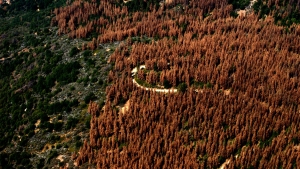
Dead trees may find new life in California. Credit: U.S. Forest Service
Burning biomass steps on the gas
In a 12-year span since 2007, wildfires burned 690 square miles in the northern Sierra Nevada. Drought, a warming climate and bark-beetle infestations killed an additional 147 million California trees since 2013.
There is a growing number of citizens and officials anxious to put those trees and their thick undergrowth to use before they ignite large-scale wildfires, pollute the air with choking smoke, and release large amounts of CO2.
In 2018 alone, California wildfires released 45.5 million metric tons of carbon dioxide, more than half as much as the state’s industrial sector emits in a year. “Catastrophic fires are completely swamping the types of gains that California is making by regulating tailpipes and all the other good work we’ve been doing,” says Graham Chisholm, senior policy adviser with the Conservation Strategy Group, a natural resources consulting firm.
That reality led Chisholm’s organization to work with Lawrence Livermore National Laboratory on developing improved forestry practices and converting waste biomass to fuels. A key, says a report by the Laboratory, is ensuring that the growing amount of waste biomass does not further contribute to California’s carbon releases. That could mean converting the biomass into renewable biofuels or burning it using carbon capture and storage.





